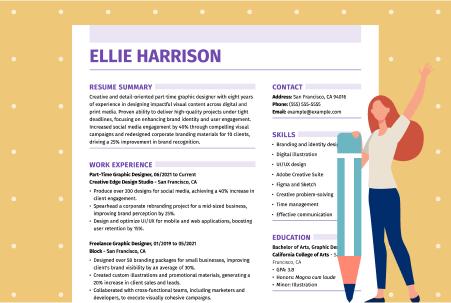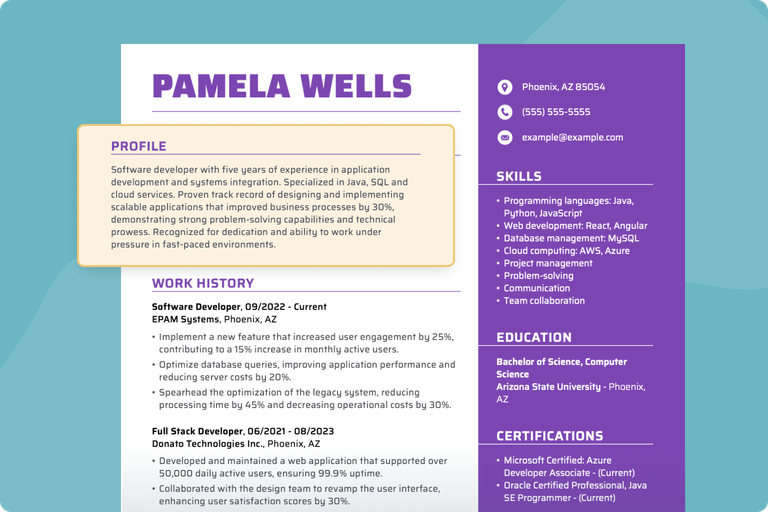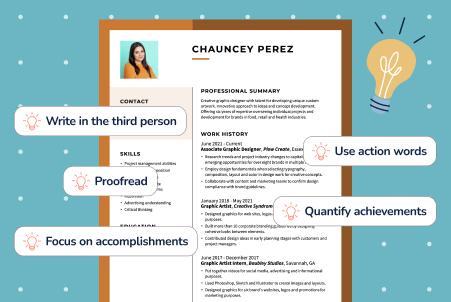Resume Header Examples & Writing Guide for 2025

Our customers have been hired at: *Foot Note
Your resume header is the first element of your application that hiring managers see, and it needs to be eye-catching and professional to make a strong first impression.
A clear, well-structured header doesn’t just offer potential employers a quick way to contact you for an interview—it also sets the tone for the rest of your resume.
In this guide, we’ll cover the key components of a strong resume header, offering formatting tips and resume header examples to help you craft your own.
What Is a Resume Header?
A resume header is the section at the top of your resume that includes your name, contact information, and links to professional profiles or portfolios.
The header of your resume offers hiring managers quick access to your contact information and provides the first glimpse of your professional brand.
Here is an example of a polished resume header created with our Resume Builder:
For more resume header ideas, explore our full library of resume templates. You can edit templates directly in our Resume Builder to easily create a polished resume.
What To Include in a Resume Header
A professional header sets the tone for the rest of your resume and demonstrates your attention to detail and organizational skills. Explore what to include in the header for your resume below.
First and last name
Your name should be the most prominent element in your resume header. Use a larger font size than the body text to make it stand out (typically 18-24 points).
Avoid nicknames unless they’re the name you go by professionally. Stick with the version of your name that you would want an employer to use in formal communication.
This helps create a consistent, professional image across your resume, cover letter, and any other materials like a LinkedIn profile or portfolio site.
Phone number
List a reliable number where hiring managers can easily reach you. Double-check for typos and make sure your voicemail greeting is professional and appropriate.
Our resume examples show options for where to add your phone number. You can edit our examples directly in our Resume Builder to add your information, and we'll handle the formatting:
Email address
Emails are essential for hiring managers to contact candidates. If your name is taken, use your full name or a variation of it in your email address, such as your middle initial.
Avoid using nicknames, numbers, or unprofessional language in your email address. Choose a reputable email service provider, such as Gmail or Outlook, for a more professional image.
You can also create a clear and concise email signature that includes your full name, phone number, and any relevant professional links (e.g., LinkedIn profile).
Your location
Listing your city and state provides location context for recruiters without disclosing your full home address, which isn’t required on a resume.
This is especially helpful for roles that prioritize local candidates or require relocation. If you're open to remote work or relocating, you can mention that in your cover letter.
Relevant links
Professional links, including portfolios, LinkedIn, or your professional profile, provide employers with additional information about your qualifications and experience.
Including professional websites or LinkedIn on your resume can enhance your credibility and demonstrate your knowledge and expertise in the field.
You can add icons to your resume next to your phone number, email, or LinkedIn URL. When used sparingly, icons can give your resume header a modern, visually appealing look.
Professional title or credentials
Adding a professional title—like Marketing Manager, Registered Nurse, or Full-Stack Developer—below your name can instantly show employers who you are and what you do.
This section is optional but recommended, especially if you are applying for a job that requires a specific skill set or expertise. It helps position you for the specific role you're targeting.
If you have relevant credentials or certifications (e.g., CPA, PMP, RN), you can include them after your name to highlight your qualifications right away.
Resume Header Examples
The resume header samples below show you how to organize your contact details, title, and links in a clean, professional layout.
Split header
Your full name appears on the left side of the header, while your contact details—like phone number, email, LinkedIn, and location—are aligned on the right.
This resume header format draws attention to your name while making it easy for recruiters to find your contact details at a glance. This organizes your information in a clear, scannable way.
It’s especially effective in single-column resumes where space efficiency matters. This is an excellent choice for mid to senior-level applicants, and roles in tech, business, or design.
Centered header
All elements—your name, contact info, and optional title—are centered at the top of the page. This layout gives your resume a clean, symmetrical look.
Having your resume header at the center of your document draws attention to your personal information and makes it easier for employers to contact you.
Additionally, a centered header can create a balanced and visually appealing layout, enhancing the overall presentation of your resume.
Two-column header
Placing your resume header in a column format on your resume creates a clear separation between your personal information and the rest of your resume content.
Your name and job title appear on one side (either centralized, to the left, or the right), while your contact information is displayed in its own separate section.
A two-column resume header can give your resume a professional and polished look, making it easier for employers to quickly locate and reference your contact details.
Tips for Writing a Strong Resume Header
Explore guidance below on how to write a resume header that clearly and effectively displays your essential contact information and makes a strong first impression.
Keep it clean and simple
Your resume header should be concise, simple, and easy to read. Use a clear and legible resume font, such as Arial, Helvetica, Verdana, or Calibri.
Avoid using any fancy or decorative fonts that may be difficult to read by hiring managers and applicant tracking systems (ATS) used to scan and organize resumes.
We recommend using our ATS Resume Checker to scan your resume for common errors, such as formatting issues in your header or overly decorative fonts that might confuse ATS tools.
Use font sizes strategically
Make your name stand out by using a larger font size—typically between 18-24 points. For the rest of your header details (like your contact info), stick to a smaller, readable size—around 10-12 points.
This creates a clear visual hierarchy and keeps your layout balanced and professional. Adjusting font sizes can help you achieve your desired resume length and appearance.
Keep it professional
Your resume header sets the tone for your entire application, so it’s important that it looks polished and appropriate for the role you’re targeting.
Avoid using overly decorative elements, flashy colors, or personal photos—unless you’re applying in a country or industry where a headshot is standard.
Use a professional-sounding email address (ideally based on your name), and don’t include anything that could appear unprofessional, such as outdated social media links.
Think of your header as your business card—it should make a strong first impression and reflect your professionalism at a glance.
Match your resume and cover letter header
Use a consistent format for your resume header and cover letter header to create a unified, professional appearance.
Matching elements like your name, contact information, and styling make it easier for hiring managers to connect your documents at a glance.
A coordinated cover letter header reinforces your brand and shows that you pay attention to details, an important quality in any job applicant.
Make sure it’s ATS-friendly
Avoid using text boxes, images, or unusual formatting that might confuse applicant tracking systems. An ATS-friendly resume is essential for ensuring your resume reaches hiring managers.
Make sure to place your header in the body of your resume instead of the header and footer sections while using word processing programs.
Tailor to your industry
Research common resume styles in your field, and create a targeted resume by choosing a header layout and design that reflects both your personality and the expectations of potential employers.
In traditional industries like finance, law, government, or healthcare, employers expect a straightforward and polished presentation. That means sticking to simple, professional fonts, using a standard layout, and avoiding unnecessary design elements.
On the other hand, creative and tech-driven fields—like design, marketing, media, and software development—often welcome a bit more personality. In these cases, your resume header can include subtle design touches like modern fonts, minimalist icons, or a hint of color.
Review and proofread
Your resume header is the first thing a hiring manager sees, and any errors or typos can create a negative impression and make it difficult for employers to contact you.
Double-check every part of your header. Confirm that your contact details are accurate, your LinkedIn URL works, and your name is spelled exactly as you use it professionally.
Key Takeaways
- A resume header is a crucial element that sets the tone for your entire resume. It should be clear, professional, and easy to read.
- Your name should be the most prominent feature in the resume header. Use a larger font or bold formatting to make it stand out.
- Include essential contact information in the resume header, such as your phone number, email address, and LinkedIn profile URL.
- Tailor your resume header to the job you are applying for. Consider the industry and the desired impression you want to make.
FAQ
What should the header on a resume include?
A header for a resume typically includes your full name, professional title or desired job position, and contact information.
You could also add links to an up-to-date portfolio or professional profile. For example, a resume header might include the following information:
- Karl Smith, Software Engineer
- Los Angeles, CA, 90001
- Phone: (555) 555-5555
- Email: karl.smith@email.com
- LinkedIn.com/in/karlsmith
- Bold.pro
Regardless of your experience level or the resume format you use, a well-crafted resume header is essential for ensuring that the hiring manager can contact you for an interview.
What size font should your name be in your resume header?
Your name should be the most prominent element in your resume header, typically using a font size between 18 and 24 points.
This ensures it stands out clearly from the rest of your content, helping recruiters quickly identify whose resume they’re reviewing.
Pair it with smaller font sizes (around 10-12 points) for your contact information to create a clear visual hierarchy and maintain a polished, balanced layout.
How do you make a resume header in Word?
To make a resume header in Word, start by typing your full name at the top of the page in a larger, bold font (18-24 pt.).
On the next line, add your contact information—like your phone number, email, city and state, and LinkedIn URL—in a smaller font (10-12 pt.).
You can center the text, left-align it, or use a two-column layout by inserting a table with one row and two columns (then remove the borders).
Keep the design simple, and save your file as a PDF to preserve formatting. We also have a selection of Microsoft Word resume templates that you can edit with your information.
How do you write a resume header for a two-page resume?
When writing a resume header for a two-page resume, include a condensed version of your header on the second page.
It doesn’t need to be as prominent—just your name and the page number are usually enough (e.g., Jane Smith | Page 2).
This keeps your document organized and ensures recruiters know whose resume they’re viewing, even if pages get separated.
How we reviewed this article
Since 2012, we have helped more than 11 million job seekers. We want to make your career journey accessible and manageable through our services and Career Center’s how-to guides and tips. In our commitment to bring you a transparent process, we present our Editorial Process.
Our customers have been hired at:*Foot Note











